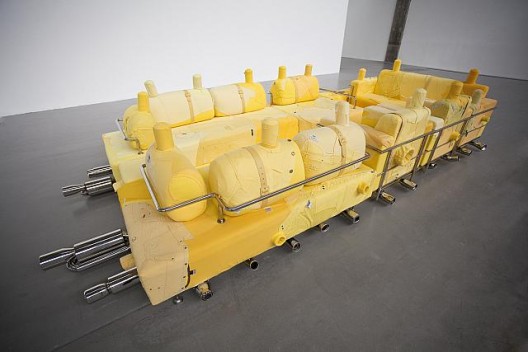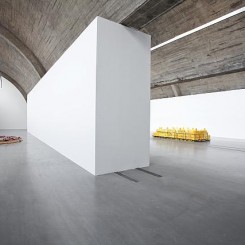“Nowhere to Land”: Yin Xiuzhen solo exhibition
Pace Beijing (No. 2 Jiuxianqiao Road, 798 Art District) Jul 20–Sep 28, 2013.
A gleaming piece of machinery sits still and solitary in the center of the gallery space; the workings of the machine hold two giant black tires suspended in mid-air. The bodies of the tires are wrapped tightly in cloth. Into the cloth-wrapped tires, the artist has sewn stumpy protrusions which look like tubular sweater-cuffs. The softness of their covering material and the futility of their spinning motion combine to make the tires seem all the more feeble and impotent in comparison with the cold, metallic framework holding them aloft. This is the artist Yin Xiuzhen’s 2012 work “Nowhere to Land”, and with nowhere to land, these massive wheels remain suspended in an uncomfortable, frenzied in-between state.

Yin Xiuzhen,”Life‐raft”, installation (sofa, tailpipes, used clothes, high density board), 93 x 258 x 533.5 cm, 2013
尹秀珍,《救生筏》,装置(沙发,尾喉,穿过的衣服,高密度板),93 x 533.5 x 258 cm,2013
This piece is the namesake for Yin’s solo show “Nowhere to Land” at Pace Beijing which opened on July 20, 2013. Apart from this large-scale piece, most of the other works on show were done this year. The current exhibition has not deviated from Yin Xiuzhen’s usual focus on the interplay of personal and collective experience; she works individual perception into the vastness of social change, the course of history and even topics as broad as life and the universe. As an example, the installation “Black Hole” was born of the artist’s personal interest in the scientific theory behind this name. In 2010, she created a work by the same name out of the metal skins of shipping containers in order to comment on the explosion of wide-spread desire for material satisfaction brought on by globalized trade. The new “Black Hole” currently on show outwardly looks very similar to her earlier work, but the artist has wrapped the surface of the diamond-shaped piece with a layer of worn clothing, bringing a personal element into the work. People usually separate Yin’s work into two categories—those dealing with personal experience and those focused on social or public issues. Based on this piece, however, it appears the line between these two categories is becoming more and more blurred. As a contemporary artist who has traveled the world, Yin Xiuzhen has been in continuous contact with different cultures, societies and histories in flux. Through her travels in time and space, she has absorbed the scents, styles and times of her surroundings—much like the fabric of a well-worn garment. As an individual entity, she is able to filter the magnificent and vast structures of what she has encountered through the lens of personal experience.

Yin Xiuzhen,“Black Hole”,installation (multi‐layer board, used clothes, LED lights),150 x dia. 250 cm, 2013
尹秀珍,《黑洞》, 装置(多层板,穿过的衣服,灯),150 x dia. 250 cm,2013
There are various ways to draw out collective memory, from Wang Guangyi’s Great Criticism to the multitude of ways in which artists have long mocked and manipulated the image of Mao; from the cynical realists with their depictions of countless grinning figures, their bald heads gleaming under the sun, to the post-80s cartoon generation and the incorporation of animation into their style. Different time periods make their mark clearly on the vast majority of work; tagged and labeled, pieces can easily be organized along the timeline of contemporary art in China. However, Yin Xiuzhen’s work lacks this clear-cut sense of belonging to any time period or style. Her works are flexible, vague and ambiguous. The artist intentionally avoids being pigeon-holed into any sort of two-dimensional definition. Faced with changing times or social issues, she often takes the middle ground. Much like her 1995 work “Washing River”, Yin Xiuzhen’s habit is of gradual advancement; conscious of the insignificance of the individual body, she allows her personal experience to seep gradually into the greater ocean of the topic at hand. She is an artist who works methodically, moving mountains one handful at a time and weaving her story thread by thread.

Yin Xiuzhen,“Traffic Barrier—Yellow Fog”,installation (acrylic, wooden board, used clothes),53.6 x 60 x 30 cm, 2013
尹秀珍,《隔离墩‐黄雾》, 装置(丙烯,木板,穿过的衣服),53.6 x 60 x 30 cm,2013

Yin Xiuzhen,“Traffic Barrier—Chang’an Avenue No.1”, installation (acrylic, wooden board, used clothes),53.6 x 60 x 30 cm, 2013
尹秀珍,《隔离墩‐长安街1》, 装置(丙烯,木板,穿过的衣服),53.6 x 60 x 30 cm,2013
Traffic Barrier—another series currently on view—moves in the same fashion. Built from pieces of wooden board, the artist has re-created the ubiquitous construction barrier; only instead of metal bars, the supports are again made of used clothing. Beijing street scenes are drawn on the traffic barriers in acrylic, as if the artist is hinting at the imprints left on the barriers by the changing scenery of the city around them. Doubtless, this is meant to signify the fragmentation of the collective memories of Beijingers like Yin Xiuzhen. The names of locations like “Chang’an Road” and phenomena such as “yellow fog” are sure to ring with familiarity for any of the city’s residents. What’s more, the artist has achieved a subtle balance between fragility and solemnity by choosing to convey personal experience and collective memory through the use of easily destroyed material such as wooden planks and worn clothing.

Yin Xiuzhen,”Life‐raft”, installation (sofa, tailpipes, used clothes, high density board), 93 x 258 x 533.5 cm, 2013
尹秀珍,《救生筏》,装置(沙发,尾喉,穿过的衣服,高密度板),93 x 533.5 x 258 cm,2013
The continuous transformation of material substances has always been a favored stomping ground for Yin Xiuzhen. Currently on show, the piece “Life” is formed of second-hand clothing sewn into countless cigarettes.The main body of another piece—“Life-raft”—is composed of a used sofa. Prior to the current show, she created different-sized suit cases out of Styrofoam (“Transfer Station,” 2010), transformed a bus with clothing (“Collective Subconscious,” 2007), and sewed a massive human brain out of textile (“Thought,” 2010). Confronted with these methods, one cannot help but think of Judy Chicago’s “The Dinner Party,” Méret Oppenheim’s “Breakfast in Fur” (1936) and Oldenburg’s juxtaposition of medium and subject—whisks made of fabric and rabbits and balloons formed of stainless steel. After changing the purpose and context of the medium, the attributes once belonging to the object are removed, and new meaning can be injected. The paradoxical and alienating effect of this technique always gives viewers food for thought.

Yin Xiuzhen,“Unbearable Warmth”,Installation (1000 scarves),dia. 365cm×h. 25cm, 2008
尹秀珍,《不能承受之暖》, 装置(1000条围巾),直径365公分×高25公分,2008
Clearly, though, Yin’s execution of the media she uses differs from any of the aforementioned artists, because her emphasis is not limited to the material properties of the objects in use; rather, her main focus is directed toward the experiences and individual memories which cling to the materials she uses. Thus, it is not a leap to say Yin’s true medium is not the material itself, but the specific meaning and significance each piece possesses. Her devotion to using old clothing in her work is not inspired by the texture of the material; instead, she is fascinated by the sense of culture, history and experience they represent. They are tapestries sewn from memory, and her infatuation is that of a child’s captivation with the scent of her mother’s closet. In “Unbearable Warmth,” she has created a massive whirlpool of color formed of a thousand scarves. The implication of warmth from the scarves themselves are wrapped time and time again with conscious memories of warmth on the viewer’s part, drawing the viewers into the center of the vortex until we are unable to pull ourselves away. In 2007, again using items of old clothing, the artist employed a similar technique and transformed an ordinary blue bus into a cathedral-like tunnel flanked by luminous panes of stained glass, cocooning viewers in an intoxicating and spiritual experience, enticing them to run their minds over distant memories long-faded yet full of lingering warmth.
In his most famous work, Milan Kundera asked: “Is heaviness truly deplorable and lightness splendid?” In the face of Yin’s work, we can’t help but wonder also whether warmth is necessarily positive. By inviting us to reminisce about the past, the artist also conveys a subtle but profound sense of unease—a life-raft covered in clothing cannot help but sink, tires suspended in mid-air cannot help but ceaselessly spin. The brilliance of fireworks is but an instant from extinguishing darkness (Fireworks series, 2013); calmed by the whirlpool’s warmth, one is but moments away from drowning. In order to criticize social realities, Yin Xiuzhen employs an attitude somewhat comparable to soft realism. This criticism is softly spoken, unsure and hesitant. From it, one gets a feeling comparable to the atmosphere of the recent and popular film Tiny Times—where the main characters and the world they move through seem to teeter on the edge of an abyss masked by prosperity. In Yin Xiuzhen’s work, the warmth obtained from the layers of scarves is unbearable, and that which appears ethereal and hazy hides the greatest danger. This is because “The absolute absence of burden causes man to become lighter than air, to soar into heights, take leave of the earth and his earthly being, and become only half real, his movements as free as they are insignificant” (1) . Leaving the earth behind, we find ourselves adrift—forever without a place to land.
(1) Milan Kundera, The Unbearable Lightness of Being (New York: Harper & Row), 1984


